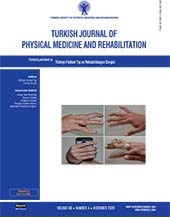The effects of bracing on sagittal spinopelvic parameters and Cobb angle in adolescents with idiopathic scoliosis: A before-after clinical study
2 Department of Orthopaedic Surgery, Iran University of Medical Sciences, Shafa Yahyaiian Hospital, Tehran, Iran DOI : 10.5606/tftrd.2020.4955 Objectives: This study aims to evaluate the effects of bracing on the Cobb angle and sagittal spinopelvic parameters in adolescent idiopathic scoliosis (AIS) patients.
Patients and methods: A total of 25 adolescents (2 males, 23 females; mean age 12.7±1.6; range, 10-15 years) with AIS who received bracing between January 2000 and June 2017 were retrospectively analyzed. The initial and final out-of-brace radiographs of 25 AIS patients were analyzed with regard to the spinopelvic parameters. The pelvic incidence (PI), pelvic tilt (PT), sacral slope (SS), Cobb angle, thoracic kyphosis (TK), and lumbar lordosis (LL) were measured.
Results: The mean age at the initiation of bracing was 12.7±1.6 years. The mean initial Cobb angle was 31.8°±5.9°. There were no statistically significant differences between the baseline and the final measurements of the PI, PT, and SS. However, there were statistically significant differences between the baseline and the final measurements of the TK, LL, and Cobb angle. A significant correlation was observed between the PI and Cobb angle and TK and between the LL and SS.
Conclusion: Our study results show significant associations between the sagittal pelvic parameters and the spinal parameters during the brace treatment of adolescents with idiopathic scoliosis.
Keywords : Adolescent idiopathic scoliosis, brace, parameters, pelvic incidence, pelvic tilt, sacral slope, spinopelvic

















